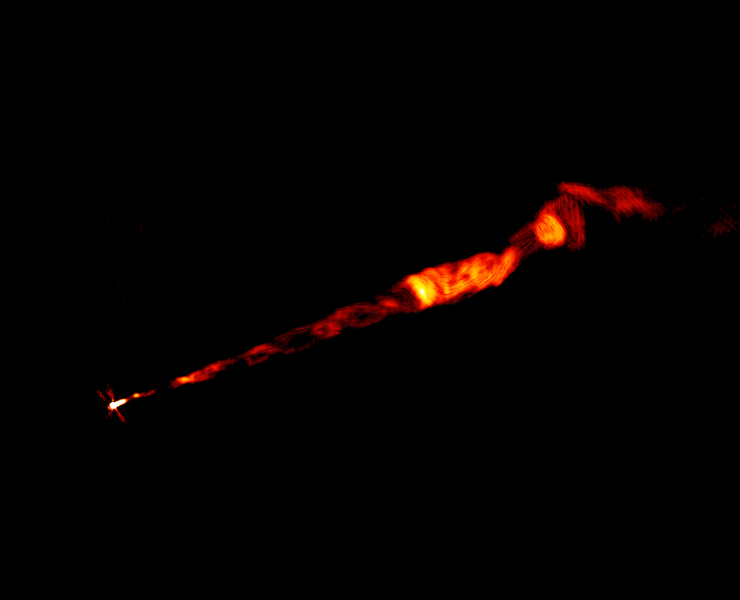
M87’s jet
Our own DNA (our genetic encoding) has the shape of a double helix. That’s partly why it’s so fascinating to see the image above, and to hear the announcement this week (December 7, 2021), of the double-helix structure in the jet extending from the supergiant galaxy M87. Astronomers used the iconic Karl G. Jansky Very Large Array – a radio telescope, located on the Plains of San Agustin in central New Mexico – to make the discovery. And they reported their findings on December 7 in the peer-reviewed Astrophysical Journal Letters.
M87 is the galaxy whose central supermassive black hole was imaged directly in 2019. It’s some 50 million light-years away, nearby in cosmological terms. We can’t see its individual stars clearly. But we know the central black hole has a mass equal to 6-and-a-half billion of our suns. And we’ve long known that a jet extends from this black hole. The jet consists of electrons and sub-atomic particles moving at near-light speed.
Astronomer Alice Pasetto of the National Autonomous University of Mexico led of the team that made the discovery. She said in a statement:
By making high-quality VLA images at several different radio wavelengths of the galaxy M87, we were able to reveal the 3-dimensional structure of the magnetic field in this jet for the first time. The material in this jet traces a double helix, similar to the structure of DNA.
The statement, from the National Radio Astronomy Observatory, confirmed that the:
… jet of material propelled from the core of a giant galaxy is channeled by a corkscrew-shaped magnetic field out to nearly 3,300 light-years from the galaxy’s central supermassive black hole. That is much farther than such a magnetic field previously had been detected in a galactic jet.

EarthSky 2022 lunar calendars now available! They make great gifts. Order now. Going fast!
How they managed to ‘see’ it
So the magnetic field portion of the jet is now known to extend at least 3,300 light-years. Meanwhile, the visible length of the jet (in optical light) is 5,000 light-years. And M87’s jet has been seen at radio wavelengths to extend 100,000 light-years. That’s about the diameter of our entire Milky Way galaxy, by the way. The NRAO statement continued:
Pasetto and her colleagues used the VLA to reveal details of the magnetic field by tracing the polarization, or alignment, of radio waves emitted from it, and by measuring the field’s strength across different parts of the jet. Their observations, made using the VLA’s widest configuration that provides the highest resolution, produced very detailed images of the galaxy’s jet.

Not unexpected
Another team member, astronomer Jose M. Marti of the University of Valencia in Spain, added:
Helical magnetic fields are expected close to the black hole, and are thought to play a highly important role in channeling the material into a narrow jet, but we didn’t expect to find such a strong helical field extending so far outward.
The magnetic field would be expected to weaken with its distance from the black hole. But these scientists have ideas on why the field extends so far. And they intend to study M87’s jet further. Co-author Jose L. Gomez of the Instituto de Astrofísica de Andalucía (CSIC) in Granada, Spain, said:
M87 is relatively near to us and its jet is very powerful, making it an excellent target for study. The clues it gives us can help us understand this very important and ubiquitous phenomenon in the universe.

Bottom line: M87’s jet – a black-hole-powerd stream of sub-atomic particles – streaming outward some 8,000 light-years, traveling at near-light-speed. Also, it’s corkscrew-shaped!
Source: Reading M87’s DNA: A Double Helix Revealing a Large-scale Helical Magnetic Field











